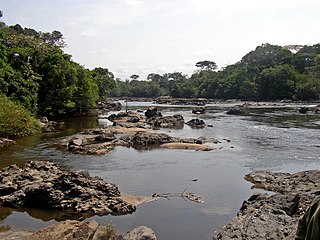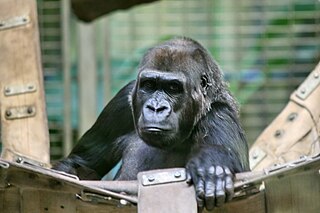Related Research Articles

The okapi, also known as the forest giraffe, Congolese giraffe and zebra giraffe, is an artiodactyl mammal that is endemic to the northeast Democratic Republic of the Congo in central Africa. It is the only species in the genus Okapia. Although the okapi has striped markings reminiscent of zebras, it is most closely related to the giraffe. The okapi and the giraffe are the only living members of the family Giraffidae.

Poaching is the illegal hunting or capturing of wild animals, usually associated with land use rights. Poaching was once performed by impoverished peasants for subsistence purposes and to supplement meager diets. It was set against the hunting privileges of nobility and territorial rulers.

The Okapi Wildlife Reserve is a wildlife reserve in the Ituri Forest in the north-east of the Democratic Republic of the Congo, near the borders with South Sudan and Uganda. At approximately 14,000 km2, it covers approximately one-fifth of the area of the forest. In 1996, the Okapi Wildlife Reserve was designated a UNESCO World Heritage Site, due to its large population of endangered okapis and its high overall biodiversity.

Virunga National Park is a national park in the Albertine Rift Valley in the eastern part of the Democratic Republic of the Congo. It was created in 1925. In elevation, it ranges from 680 m (2,230 ft) in the Semliki River valley to 5,109 m (16,762 ft) in the Rwenzori Mountains. From north to south it extends approximately 300 km (190 mi), largely along the international borders with Uganda and Rwanda in the east. It covers an area of 8,090 km2 (3,120 sq mi).
Zakouma National Park is a 1,158-square-mile (3,000 km2) national park in southeastern Chad, straddling the border of Guéra Region and Salamat Region. Zakouma is the nation's oldest national park, declared a national park in 1963 by presidential decree, giving it the highest form of protection available under the nation's laws. It has been managed by the nonprofit conservation organization African Parks since 2010 in partnership with Chad's government.

Garamba National Park is a national park in the north-eastern Democratic Republic of the Congo covering nearly 5,200 km2 (2,000 sq mi). It is among Africa's oldest parks and was designated a World Heritage Site by UNESCO in 1980 for its protection of critical habitat for northern white rhinoceroses, African elephants, hippopotamuses, and giraffes. Garamba National Park has been managed by African Parks in partnership with the Institut Congolais pour la Conservation de la Nature since 2005.
The Nyungwe Forest is located in southwestern Rwanda, on the border with Burundi, where it is contiguous with the Kibira National Park to the south, and Lake Kivu and the Democratic Republic of the Congo to the west. The Nyungwe rainforest is probably the best preserved montane rainforest in Africa. It is located in the watershed between the basin of the river Congo to the west and the basin of the river Nile to the east. From the east side of the Nyungwe forest comes also one of the branches of the Nile sources.

Environmental issues in Kenya include deforestation, soil erosion, desertification, water shortage and degraded water quality, flooding, poaching, and domestic and industrial pollution.

The wildlife of the Democratic Republic of the Congo includes its flora and fauna, comprising a large biodiversity in rainforests, seasonally flooded forests and grasslands.
Odzala-Kokoua National Park is a national park in the Republic of the Congo. The park was first protected in 1935, declared a biosphere reserve in 1977, and granted official designation by presidential decree in 2001. Odzala-Kokoua has approximately 100 mammals species, and one of the continent's most diverse primate populations. The nonprofit conservation organization African Parks began managing the park in collaboration with the Ministry of Forest Economy, Sustainable Development and Environment of the Republic of the Congo in 2010.
The Cuvette Centrale is a region of forests and wetlands in the Democratic Republic of the Congo. Some definitions consider the region to extend into the Republic of the Congo as well. It lies in the center of the Congo Basin, bounded on the west, north and east by the arc of the Congo River.
Iain Douglas-HamiltonCBE is a British zoologist. He is an authority on elephant behaviour and conservation. He attended Gordonstoun School, and later Oxford University where he earned a degree in Zoology and a D.Phil studying the Ecology and Behaviour of the African Elephant. His work in the 1960s paved the way for much of today’s understanding of elephants and current conservation practices. During the 1970s, he investigated the status of elephants throughout Africa and was the first to alert the world to the ivory poaching crisis. He chronicled the diminution of Africa’s elephant population by half between 1979 and 1989 and was instrumental in bringing about the world ivory trade ban. In 1993, Douglas-Hamilton founded Save the Elephants (STE) a charity dedicated specifically to elephants. Since that time, Save the Elephants has conducted research on elephant across Africa and has increased public awareness of the many dangers that threaten elephants and the habitats in which they live. Fundamental to his work at STE, Douglas-Hamilton pioneered GPS tracking of elephants in Africa, which has become a standard and widely emulated survey technique; it also guides the deployment of rangers to protect vulnerable and key elephant populations. Douglas-Hamilton and his wife, Oria, have co-authored two award-winning books, Among the Elephants (1975) and Battle for the Elephants (1992), and have made several television films. Dr. Iain Douglas-Hamilton was awarded the 2010 Indianapolis Prize, one of the world's leading awards for animal conservation. In 2013 The Elephant Crisis Fund was established to confront the threat to elephants by supporting the most urgent, important and catalytic projects across the crisis to stop the killing, stop the trafficking and end the demand for ivory. In October 2014 he was presented with the George B Rabb Conservation Medal by the Chicago Zoological Society (CZS) for his authoritative work to benefit African elephants. In 2015 he was awarded the Commander of the British Empire and was presented the Lifetime Achievement Award by San Diego Zoological Society with most recently being awarded the Tanzanian Wildlife Research Institute’s (TAWIRI) Tanzania Wildlife Research Award for his lifelong devotion to elephants. Currently he is focused on winning hearts and minds to help reduce the demand for ivory, and focus on understanding elephant’s reasons for movements, and their deep history in time.
Boumba Bek National Park is a national park in extreme southeastern Cameroon, located in its East Province.
Nki National Park is a national park in southeastern Cameroon, located in its East Province. The closest towns to Nki are Yokadouma, Moloundou and Lomie, beyond which are rural lands. Due to its remoteness, Nki has been described as "the last true wilderness." It has a large and varied ecosystem, and it is home to over 265 species of birds, and the forests of Cameroon contain some of the highest population density of forest elephants of any nation with an elephant density of roughly 2.5 per square kilometer for Nki and neighboring Boumba Bek National Park combined. These animals are victims of poaching, which has been a major problem since an economic depression in the 1980s. The indigenous people follow in the footsteps of the poachers, attracted by the financial opportunities. The removal of logging industries from the park, on the other hand, has been a success; it is no longer considered a major threat to Nki's wilderness.

Nouabalé-Ndoki National Park is a national park in the Republic of the Congo. Established in 1993, in the northern provinces of Congo, it is home to forest elephants, great apes, including western lowland gorillas and the eastern sub-species of chimpanzees and bongo. It is 3,921.61 km2 (1,514.14 sq mi) of pristine tropical rainforest with no human habitation within it and with human population densities in its periphery that are comparatively low for the sub-region. The forests have a rich biodiversity of 300 bird species, plus 1,000 plant and tree species which include endangered mahoganies.
Sankuru Nature Reserve is a protected area in the Democratic Republic of the Congo. It was created in November 2007 to protect a forest area home to bonobo, okapi and African forest elephant. The reserve has not been managed effectively, and suffers from ongoing deforestation and bushmeat hunting.

The wildlife of the Central African Republic is in the vast natural habitat in the Central African Republic (CAR) located between the Congo Basin's rain forests and large savannas, where the human density was smaller than 0.5 per km2 prior to 1850. The forest area of 22.755 million, considered one of the richest storehouses of wildlife spread over national parks, hunting reserves and community hunting areas, experienced an alarming loss of wildlife because of greed for ivory and bushmeat exploitation by hunters – mostly Arab slavers from across the borders of the Central African Republic with Chad and Sudan.

The Okapi Conservation Project (OCP) was founded in 1987 for the protection of the okapis and their habitat. Okapis are found only in the Democratic Republic of Congo and are seen as the major flagship species of the Ituri Forest. The OCP has about one hundred staff members and one hundred and ten government rangers under the direction of the Institute in Congo for the Conservation of Nature. The Okapi Conservation Project is partnered with the Wildlife Conservation Network. OCP's founder John Lukas is also a founding member of the Wildlife Conservation Network. In 1992 the project helped create the Okapi Wildlife Reserve, encompassing 13,700 square kilometers of the Ituri Forest, which was designated as a United Nations World Heritage Site in 1996.
Paul Sadala, alias "Morgan", was a Congolese militant, poacher and faction leader. Throughout the 2000s, Sadala grew into an elephant poaching kingpin in northeastern Congo, particularly in and around the Okapi Wildlife Reserve. He was arrested on at least two occasions by ICCN park rangers. In 2011, styled Morgan, he initiated the militant group "Mai Mai Lumumba" while it was commonly known as "Mai Mai Morgan". Morgan and his rebels were accused of committing the most severe crimes, such as cannibalism, rape, kidnapping and murder. Their most high-profile attacks included a siege of Epulu village, the headquarters of the Okapi Wildlife Reserve early on the morning of June 24, 2012. Morgan occupied Epulu until the afternoon of June 25, 2012 before vanishing back into the forest. In the wake of this attack, 7 people were killed, while the entire captive population of okapi in Epulu's breeding center were also shot and killed by the rebels. FARDC soldiers arrived and looted the village. Morgan enjoyed support from FARDC units in Bafwasende and Kisangani In January 2013, Morgan occupied the large town of Mambasa for several hours before finally being repelled by the Congolese army.
Environmental issues in the Democratic Republic of the Congo are the consequence of compounding social and economic problems, including lack of access to clean energy, clearing of lands for agriculture and economic development, and armed conflict. Major environmental issues in DRC include deforestation, poaching, which threatens wildlife populations, water pollution and mining.
References
- ↑ Goldman Environmental Prize 2005: Corneille Ewango Archived 2007-10-30 at the Wayback Machine (Retrieved on November 5, 2007)
- 1 2 3 4 "Top Stories" (PDF). ICTE. Archived from the original (PDF) on 2013-12-03. Retrieved 2013-11-23.
- 1 2 "Protecting biodiversity and fighting "the language of guns" in the Congo". Wild Optimism. Archived from the original on 2013-12-03.
- 1 2 3 4 "Future For Nature award 2011 for Corneille Ewango". WageningenUR. Archived from the original on 2013-12-03. Retrieved 2013-11-23.
- 1 2 3 "African botanist honored for saving preserve". NBC News.
- 1 2 "Award for brave DR Congo botanist". BBC News. Apr 18, 2005.
- 1 2 "Prize Recipient". The Goldman Environmental Prize.
- ↑ "Corneille Ewango: A hero of the Congo Basin forest". YouTube. Archived from the original on 2021-12-12.